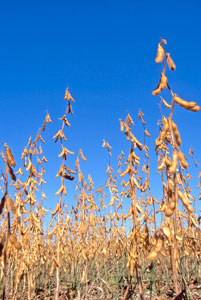
A trip to a tasty salad bar can include edamame, a small baby lima-looking vegetable that is actually an edible soybean packed with protein.
Consumption of the crunchy green bean is rapidly increasing in the United States, Japan and China. U.S. production of the bean is currently limited to about 1,000 acres nationwide, mostly in Ohio and Kentucky.
Edamame is a potential crop in low desert farm fields in Arizona and California, according to Mike Rethwisch, Extension educator with the University of Nebraska-Lincoln Extension in Butler County, Neb.
“I think edamame is a great crop opportunity in the desert Southwest,” Rethwisch said. “We can grow it here and have it ready for the fresh market when no one else in the U.S. can.”
Rethwisch is no stranger to Western agriculture. He served about 18 years as a University of California Cooperative Extension farm advisor stationed in Blythe and as a University of Arizona Extension agent in Yuma and La Paz counties. He moved to Nebraska about three years ago.
Rethwisch discussed several bean crops worth consideration in desert agriculture during the 2010 Southwest Agricultural Summit in March.
“Japanese markets prefer edamame sold as the entire plant or in the pod preferably in 25-pound bundles,” Rethwisch said. “The Chinese prefer fresh-shelled beans with two to three beans per pod.”
Rethwisch believes the desert could be a prime location for edamame production. The greater Yuma area has the labor, coolers, and other services for winter lettuce production. The key with edamame, Rethwisch says, is to harvest the crop and quickly cool the pods.
“Mechanical equipment is available to harvest the crop, but machine bruising can reduce the saleable pods by about 25 percent,” Rethwisch said. “Edamame is best harvested by hand. The entire stalk has considerable value in the Japanese market base. Net returns can bring $400-$1,300 per acre.”
Edamame production is not for the faint of heart due to high production costs. The growing season is 90-120 days. Edamame is susceptible to frost and freeze. It can be grown in the same production window as green beans in the low desert with an early spring harvest following a late winter planting.
Specialty dry beans
Growing specialty dry beans for seed is another crop option for desert growers. The multi-purpose sweet bean adzuki is used as seed for sprouts and ground into meal. The dessert bean is used in ice cream and pastries. The short plant grows from 1-2 feet in height and produces mostly red-colored beans.
Adzuki is popular in the Chinese diet. The bean is the second most important dry bean in Japan behind soybeans.
“We might not get the acreage in the desert to make it worthwhile as a large commodity, but we could grow the crop for the seed supply,” Rethwisch said. “Adzuki yields are about 4,000 pounds/acre in Minnesota. At $20 per hundredweight that would be about $800 per acre. I would expect higher yields in desert production.”
The major challenges for desert bean production include finding a market, pests (primarily insects), herbicides, and the harvest and storage.
“Whiteflies and stink bugs like beans,” Rethwisch said. “Spider mites could also pose a threat. I don’t know if the new Bagrada stink bug found in the desert last year would have an affinity for dry beans.”
Soybeans, typically grown east of the Rocky Mountains, can be grown in the desert. The plant can grow up to 6 feet tall and is usually combined in a single pass. Desert production would likely require early-maturing varieties. Selecting the wrong maturing variety for an area can result in green plants, but little seed set.
“The No. 1 challenge of growing soybeans in the desert Southwest is not growing the beans; it’s harvesting them. They shatter everywhere,” Rethwisch said. “This could be overcome by swathing the beans before reaching complete maturity and then bringing in the crop with a combine.”
Dryness is a friend and a foe in the desert; limiting diseases but encouraging insect populations, says Rethwisch. The warm weather would create the early marketing window for edamame, but generate shattering concerns for some other beans.
Beans are currently a minor crop in California agriculture compared to nuts and fruit. The top acreage includes baby and large lima beans (about 14,000 acres each), garbanzos, light red kidneys, plus about 2,000 acres each in cranberry, dark red kidney, black, pink, and pinto beans.
Recent reported values are about $1,600/acre for large limas, Rethwisch says, about $700/acre for pintos, and $1,000/acre for baby limas and black eyed peas.
“It’s a big world and the opportunities abound,” Rethwisch said. “It’s a matter of overcoming the challenges of production and marketing.”
About the Author(s)
You May Also Like






